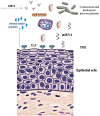Manipulating rumen microbiome and fermentation through interventions during early life: a review
- PMID: 26528276
- PMCID: PMC4604304
- DOI: 10.3389/fmicb.2015.01133
Manipulating rumen microbiome and fermentation through interventions during early life: a review
Abstract
The nutritional manipulations of the rumen microbiome to enhance productivity and health are rather limited by the resilience of the ecosystem once established in the mature rumen. Based on recent studies, it has been suggested that the microbial colonization that occurs soon after birth opens a possibility of manipulation with potential to produce lasting effects into adult life. This paper presents the state-of-the-art in relation to early life nutritional interventions by addressing three areas: the development of the rumen as an organ in regards to the nutrition of the new-born, the main factors that determine the microbial population that first colonizes and establishes in the rumen, and the key immunity players that contribute to shaping the commensal microbiota in the early stage of life to understand host-microbiome specificity. The development of the rumen epithelium and muscularization are differently affected by the nature of the diet and special care should be taken with regards to transition from liquid (milk) to solid feed. The rumen is quickly colonized by all type of microorganisms straight after birth and the colonization pattern may be influenced by several factors such as presence/absence of adult animals, the first solid diet provided, and the inclusion of compounds that prevent/facilitate the establishment of some microorganisms or the direct inoculation of specific strains. The results presented show how early life events may be related to the microbial community structure and/or the rumen activity in the animals post-weaning. This would create differences in adaptive capacity due to different early life experiences and leads to the idea of microbial programming. However, many elements need to be further studied such as: the most sensitive window of time for interventions, the best means to test long term effectiveness, the role of key microbial groups and host-immune regulations.
Keywords: early life; microbial colonization; rumen development; rumen microbiome; weaning.
Figures
References
-
- Abecia L., Ramos-Morales E., Martínez-Fernandez G., Arco A., Martín-García A. I., Newbold C. J., et al. (2014b). Feeding management in early life influences microbial colonisation and fermentation in the rumen of newborn goat kids. Anim. Prod. Sci. 54 1449–1454.
-
- Baldwin R. L., McLeod K. R. (2000). Effects of diet forage:concentrate ratio and metabolizable energy intake on isolated rumen epithelial cell metabolism in vitro. J. Anim. Sci. 78 771–783. - PubMed
Publication types
LinkOut - more resources
Full Text Sources
Other Literature Sources


